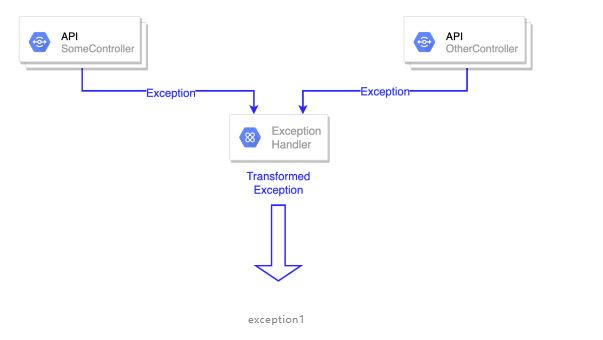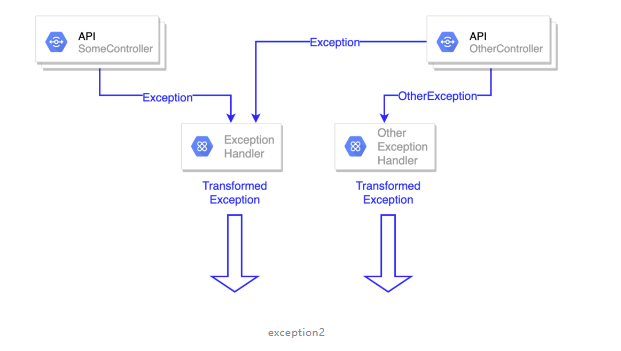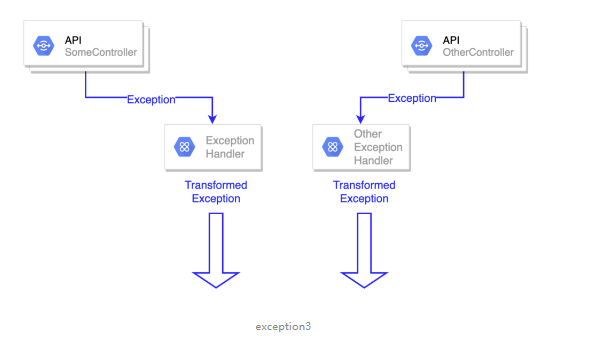前言
在平时的 API 开发过程中,总会遇到一些错误异常没有捕捉到的情况。那有的小伙伴可能会想,这还不简单么,我在 API 最外层加一个 try...catch 不就完事了。
哈哈哈,没错。这种方法简单粗暴。指北君曾经也是这么干的,但是你转过来想一想,你会在每一个 API 入口,都去做 try...catch 吗?这样不是代码非常丑陋的。小伙伴开始思考,突然灵光一现,说我们实现一个 AOP 来做这事不就完了。没错,使用 AOP 来实现是最佳的选择。
现在指北君就给大家来介绍介绍 Spring Boot 怎么通过注解来实现全局异常处理的。
主角 @ControllerAdvice 和 @ExceptionHandler
我们先来介绍一下今天的主角,分别是 @ControllerAdvice 和 @ExceptionHandler 。
• @ControllerAdvice 相当于 controller 的切面,主要用于 @ExceptionHandler, @InitBinder 和 @ModelAttribute,使注解标注的方法对每一个 controller 都起作用。默认对所有 controller 都起作用,当然也可以通过 @ControllerAdvice 注解中的一些属性选定符合条件的 controller 。
• @ExceptionHandler 用于异常处理的注解,可以通过 value 指定处理哪种类型的异常还可以与 @ResponseStatus 搭配使用,处理特定的 http 错误。标记的方法入参与返回值都有很大的灵活性,具体可以看注释也可以在后边的深度探究。
案例分析
今天我们就通过几种案例的方式,来给大家分析分析,怎么通过全局异常处理的方式玩转 Spring Boot 的全局异常处理。
案例一
一般的异常处理,所有的API都需要有相同的异常结构。

在这种情况下,实现是非常简单的,我们只需要创建 GeneralExceptionHandler 类,用 @ControllerAdvice 注解来注解它,并创建所需的 @ExceptionHandler ,它将处理所有由应用程序抛出的异常,如果它能找到匹配的 @ExceptionHandler,它将相应地进行转换。
@ControllerAdvice
public class GeneralExceptionHandler {
@ExceptionHandler(Exception.class)
protected ResponseEntity<Error> handleException(Exception ex) {
MyError myError = MyError.builder()
.text(ex.getMessage())
.code(ex.getErrorCode()).build();
return new ResponseEntity(myError,
HttpStatus.valueOf(ex.getErrorCode()));
}
案例二
我们有一个API,它需要有一个或多个异常以其他格式处理,与其他应用程序的 API 不同。

我们可以采取两种方式来实现这种情况。我们可以在 OtherController 内部添加 @ExceptionHandler 来处理 OtherException ,或者为 OtherController 创建新的@ControllerAdvice,以备我们也想在其他 API 中处理 OtherException。
在 OtherController 中添加 @ExceptionHandler 来处理 OtherException 的代码示例。
@RestController
@RequestMapping("/other")
public class OtherController {
@ExceptionHandler(OtherException.class)
protected ResponseEntity<Error> handleException(OtherException ex) {
MyOtherError myOtherError = MyOtherError.builder()
.message(ex.getMessage())
.origin("Other API")
.code(ex.getErrorCode()).build();
return new ResponseEntity(myOtherError,
HttpStatus.valueOf(ex.getErrorCode()));
}
只针对 OtherController 控制器的 @ControllerAdvice 的代码示例
@ControllerAdvice(assignableTypes = OtherController.class)
public class OtherExceptionHandler {
@ExceptionHandler(OtherException.class)
protected ResponseEntity<Error> handleException(OtherException ex) {
MyOtherError myOtherError = MyOtherError.builder()
.message(ex.getMessage())
.origin("Other API")
.code(ex.getErrorCode()).build();
return new ResponseEntity(myOtherError,
HttpStatus.valueOf(ex.getErrorCode()));
}
案例三
与案例二类似,我们有一个 API 需要以不同于应用程序中其他 API 的方式对异常进行格式化,但这次所有的异常都需要进行不同的转换。

为了实现这个案例,我们将不得不使用两个 @ControllerAdvice,并加上 @Order 注解的注意事项。因为现在我们需要告诉 Spring,在处理同一个异常时,哪个 @ControllerAdvice 的优先级更高。如果我们没有指定 @Order,在启动时,其中一个处理程序将自动注册为更高的顺序,我们的异常处理将变得不可预测。例如,我最近看到一个案例,如果你使用 mvn springboot:run 任务启动一个应用程序,OtherExceptionHandler 是主要的,但是当以jar形式启动时,GeneralExceptionHandler 是主要的。
@ControllerAdvice
public class GeneralExceptionHandler {
@ExceptionHandler(Exception.class)
protected ResponseEntity<Error> handleException(Exception ex) {
MyError myError = MyError.builder()
.text(ex.getMessage())
.code(ex.getErrorCode()).build();
return new ResponseEntity(myError,
HttpStatus.valueOf(ex.getErrorCode()));
@ControllerAdvice(assignableTypes = OtherController.class)
@Order(Ordered.HIGHEST_PRECEDENCE)
public class OtherExceptionHandler {
@ExceptionHandler(Exception.class)
protected ResponseEntity<Error> handleException(Exception ex) {
MyError myError = MyError.builder()
.message(ex.getMessage())
.origin("Other API")
.code(ex.getErrorCode()).build();
return new ResponseEntity(myError,
HttpStatus.valueOf(ex.getErrorCode()));
}
总结
经过上述的几个案例,指北君觉得大家应该已经能够轻松应对 Spring Boot 中大部分的全局异常处理的情况。
细心的同学也许会觉得为什么不使用 @RestControllerAdvice 呢?如果是用的 @RestControllerAdvice 注解,它会将数据自动转换成JSON格式,不再需要 ResponseEntity 的处理来。这种与 Controller 和 RestController 类似,本质是一样的,所以我们在使用全局异常处理之后可以进行灵活的选择处理。
本文转载自公共号Java极客技术。


